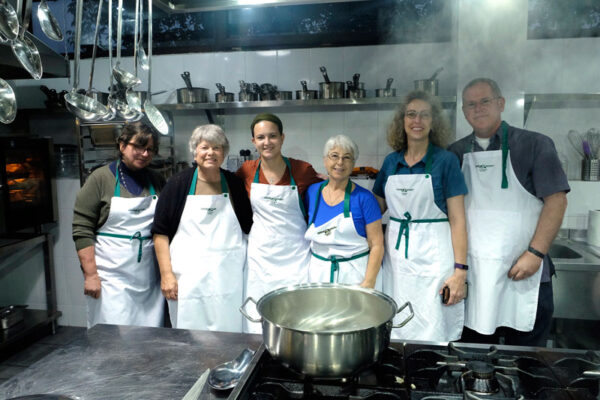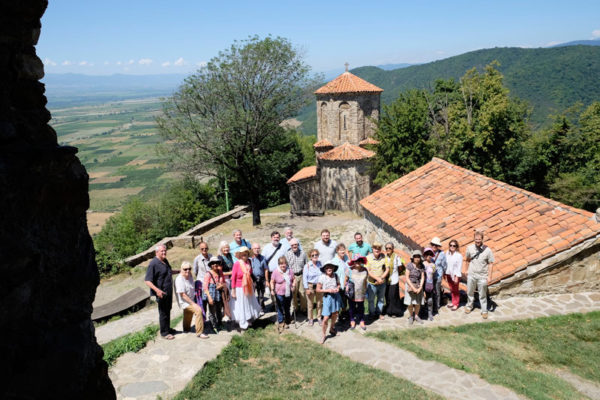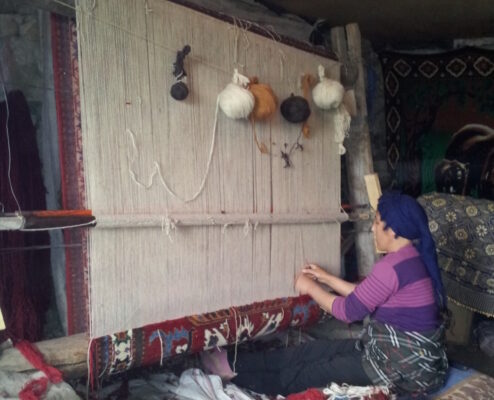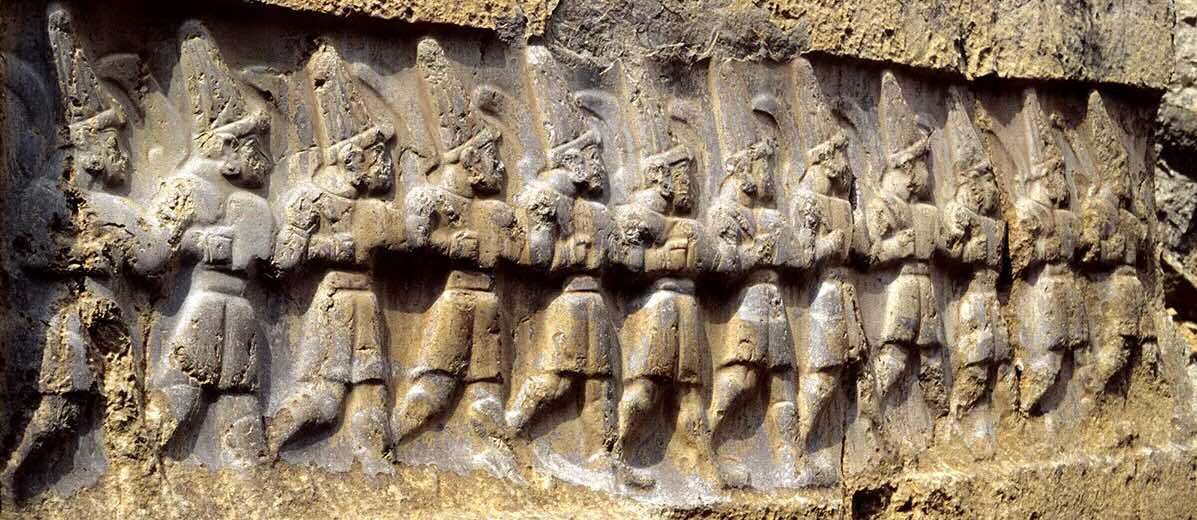Georgia & Armenia: Caucasus Cultural Tour
12-day Cultural Program (overland travel)
Music, dance, cuisine, artisans, viticulture, mountains, monasteries, vineyards, and more!
May 8-20, 2026
May, 2027
Registration: OPEN (Max 16 participants)
One of our most popular tour programs, the Georgia & Armenia cultural tour gives a broad introduction to the most important cultural sites as well as the wealth of artistic culture that flourishes in both countries today. While lectures focus on the history of these countries as early emerging states in the periphery of Rome and Persia, and later the empires of Byzantium and the Seljuk Turks, our day to day experience will be an interaction with musicians, artists, cooks, clerics, and environmentalists.
Our tour begins and ends in Tbilisi, the thriving cultural and business capital city of Georgia. Read more about the travel program below.
Our guides are expert historians and also very personable people. Many of our guests come to visit Georgia and Armenia, but leave feeling that they have joined a family, as reflected in their tour reviews. Join us for an excursion back in time, enjoying the finest in Georgia and Armenia.
Details:
- Arrive-Depart Tbilisi (airport designation TBS)
- 12 day overland travel itinerary (12 nights inclusive)
- Visas: US or EU passport holders do not need a Georgian or Armenian visa. For other nationalities, check the country listings
- Maximum 16 guests (only a deposit secures a place on tour)
Tour Leaders:
- John Graham
- Roseanna Badalyan
- Invited specialists and guest musicians
Accommodation:
- Best available boutique hotels.
Brochure:
- Contact us for the invitational tour brochure and registration form. Email: admin@johngrahamtours.com
Registration:
- Submit registration form (sent at your request)
- Send deposit of $1500 to secure your place (details in registration form)
Fees (2026):
- $4250 (book by April 24th, 2025)
- $4550 (book after April 24th, 2025)
- $580 Single supplement
- See discounts for this tour if you have been on a previous JohnGraham tour!
Payment Methods:
- Bank transfer (preferred)
- Personal check to Vermont address
- Credit card via Paypal (3% Paypal charge applies)
Post-Tour Options
- Add a 3-day extension trip up the Russian Military Highway to the highland region of Kazbegi. Includes 2 nights in Kazbegi, 1 night in Tbilisi (see the registration form for details).
Included:
- Accommodation in high quality boutique hotels specially vetted for comfort and location
- All ground transportation including airport transfers
- All meals with wine/beer as noted in itinerary
- All entrances
- Guides
- Entertainment (traditional singers, a ballet or opera if performance dates match our itinerary)
- Water on the bus, snacks (we pamper our guests!)
Not Included:
- Airfare
- Tips for primary guides and driver
- Personal services (laundry)
- Food-drink not specified in itinerary
Mobility-Fitness:
- Standard: 4/10 on the mobility scale (10 being the most demanding).
- General fitness required. There are stairs to the churches. We will have some walks, but nothing strenuous. Walks are on uneven rocky terrain, sturdy footwear required. If walks are too demanding there is always an option to skip the walk.
Special Notes:
- Flagship itinerary, most popular destinations
- This will be flower season!
- Top quality hotels on this itinerary
- Lots of arts and music on this itinerary
- Plenty of walks. Optional vigorous walks.
Weather:
- We will expect spring and early summer weather, which means it could be quite unpredictable with sun or rain every day. Prepare for temperatures between 65-85F, likely that we will have at least one thunderstorm day. Otherwise, April-May is the height of spring, we'll have many gorgeous days, with all of the fruit trees blossoming across the countryside!
Travel Program…
Our tour begins and ends in Tbilisi, the thriving cultural and business capital city of Georgia. Our accommodation in the heart of the rejuvenated Old City places us within easy walking distance of the many wonders of this ancient city including churches, mosques, synagogues, carpet shops, and boutique cafes. We will visit several newly reopened museums featuring high quality exhibits on pre-Christian gold jewelry, medieval Christian embroidery, and the Soviet occupation.
No trip to the Caucasus is complete without indulging in some of the delicious homegrown wine, as this region boasts the first evidence of cultivated grape pips (dating to 6000BC). On day 3, we travel to the Alazani Valley, where we will spend days exploring the local culture including agrarian practices such as making large clay amphoras for wine, singing, dancing, felting, and cooking traditions, and some of the important historical sites as well! Viticulture is still visibly the culture of the land as almost every local villager produces their own wine from their own grape varietals (more than 430 varietals exist in Georgia alone).
In the town of Mtskheta, we visit the UNESCO heritage sites associated with the 4th century Christianization of the Armazi dynasty kings that lived there.
For the second half of the trip, we travel south to Yerevan, the bustling capital city of Armenia, where we plan to visit a variety of sites including the Matenadaran manuscript museum, the Genocide museum, the National Museum, a carpet weaving studio, souvenir shops, and the outdoor Saturday market.
Our day trips in Armenia include site visits to the 1st century Roman-style temple at Garni, the 13th c. Haghpat Monastery - a UNESCO heritage site, Lake Sevan, and many other sites of interest. Please see the detailed itinerary in the brochure.
As on all of our tours, the leadership team prioritizes introducing our guests to real people in cultural contexts. We will have several musical encounters with singers in Georgia and instrumentalists in Armenia! Our tour pays very close attention to providing unique dishes at every meal, while being conscious of individual dietary restrictions. This tour will be a feast in all ways: intellect, spirit, and body!
Historical-Cultural view:
The southern slopes of the Great Caucasus range, stretching south to the headlands of the Tigris and Euphrates in the Eastern Anatolian Plateau, are the lands historically inhabited by Georgian and Armenian tribes.
Herodotus and Xenophon described their cultures, and many great civilizations have coveted their mountain rivers and lush valleys. The list of conquerors includes the Hittites, Greeks under Alexander, Romans under Pompeus, Parthians, Sassanid Persians, Arabs, Mongols, Tamerlane, Saffavid and Qajar Persians, Seljuk and Ottoman Turks. Even the mythological hero Jason and the Argonauts traveled here in search of the fabled Golden Fleece.
The history of the ancient city of Samshvilde [Place of the Bow] located in the border region between Georgia and Armenia (a featured site on this tour), serves as a microcosm of these vast military movements as its temporary Georgian or Armenian occupants were besieged by Alexander the Great, the Mongols, the Safavid Persians, and the Seljuk Turks, among others.
Request the full brochure! Email: admin@johngrahamtours.com
Tour Locations:
Tbilisi and Mtskheta
+ Tbilisi, capital city of Georgia, founded in the 5th century by King Vakhtang Gorgasali. A center of trade and conflict for centuries, Tbilisi has been sacked forty times by various invaders but survives today as the modern hub of the South Caucasus. Nevertheless, the downtown area is full of winding cobblestone streets, small shops and restaurants, as well as the churches, synagogues, and mosques that celebrate the diversity and history of this unique capital city. Mtskheta, the ancient capital of Iberia (East Georgia), lies at the confluence of two rivers just 20 miles upstream from Tbilisi. Dominated by the 11th c. Cathedral of the "Living Cross," Mtskheta was once the thriving trade capital of East Georgia. The Romans reached Mtskheta in 65 AD, as evidenced by the remains of a bridge left behind, and in the early Christian era, St. Nino the Enlightener worked miracles that converted King Mirian and Queen Nana to Christianity in 337 AD.
Yerevan
+ The tour begins in Yerevan, the capital city of Armenia. Once a village hamlet, Yerevan was completely redesigned on a radial plan in the early twentieth century, focused around the Opera house and several prominent museums and monuments. With boulevards oriented towards the imposing extinct volcano of Mount Ararat, pedestrians wandering between artisan shops and open air cafes might be startled by impressive views of the Ararat valley. The Matenadaran Institute of Manuscripts contains a world-class exhibit of medieval illuminated manuscripts from around the world, augmented by a map-room of ancient maps of the Caucasus region, and beautifully calligraphic Persian and Arabic official documents. Another museum of exceptional quality is the house museum of the avant-garde film-maker Sergei Parazhanov, which contains much of his little-known production in ceramics, collage, and costume.
Lake Sevan, Dilijan
+ The lake is one of the largest high-altitude fresh water lakes in the world at over 6000 feet above sea level. Interestingly, while the lake is fed by as many as 28 different rivers and streams, evaporation accounts for over 90% of its outflow. Human intervention in the ecosystem of the lake has taken its toll. In 1933, Stalin approved a plan to lower the level of the lake by 55 meters to increase arable land, produce hydro-electricity, and create fisheries. After just seven years in operation, nearly half the volume of the lake had been drained. Ever since, the Lake Sevan Commission has been attempting to stabilize the lake level by diverting other rivers through tunnels and other schemes. Historically, the lake has been highly significant, attested to in Persian, Greek, Georgian, and Armenian sources. Several medieval monuments surround the lake including the Noraduz khatchkar (cross-stones) field and the ninth century Hayravank and Sevanavank monasteries.
Debed canyon, Lori region
+ The Lori region, in the border marchlands between Armenia and Georgia, is dominated by a high-walled basalt canyon that follows the snaking contours of the Debed River. One of the primary trade routes between lowland Georgia and upland Armenia, the canyon served as an important gateway for travelers along the northern Silk Road. The scriptoria of its famous monasteries at Haghpat, Sanahin, and Akhtala grew in prominence especially in the 12th-13th centuries, when King David the Restorer of Georgia liberated the area from Arab and Seljuk control. In modern times, the region is known for industrial cities such as Vanadzor, Spitak, and Alaverdi, and was the epicenter of an earthquake in 1988 that unfortunately coincided with the economic collapse of the Soviet economy. Tourism has brought some life to Lori, as visitors flock to see the majestic grandeur of medieval monasteries perched on canyon plateaus far above the river below.
Telavi, Alazani Valley
+ Telavi, the regional capital of the Kakheti region in East Georgia, was the historical seat of the lowland Georgian kings allied with the highland tribes in Tusheti, Khevsureti, and Pshavi. In the Telavi region, at the head of the rich Alazani valley, there are many famous monasteries and castles set amidst long rows of cultivated vineyards. These include the 8th c. double-domed Kvelatsminda church, the 11th-12th monumental Alaverdi Cathedral and secluded Iqalto Academy, as well as the 16th c. Gremi fortress and Shuamta Convent. Our visits to the region always include local wine-tastings, song, and feasting!
Request the full brochure! Email: admin@johngrahamtours.com
















